|
Asgard
Author: Pierluca Zizzi
Publisher: What's Your Game? / Hutter Trade
Year: 2012
review by

| x |
|
|
|
|
|
|
|
|
|
|
|
|
|
|
|
|
|
|
|
|
|
|
|
|
|
|
|
|
|
|
|
|
|
|
|
|
|
|
|
|
|
|
|
|
|
|
|
|
|
|
|
|
|
|
|
|
|
|
|
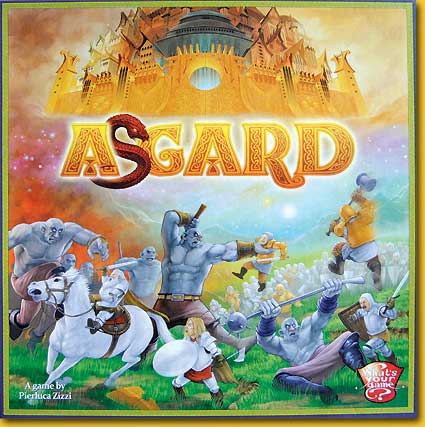 |
Baldr, Surtr, Tyr, Ragnarök; it sounds like a faltering engine! For the connoisseur of Viking mythology this may al sound very familier, for the average player this is an additional hurdle in the immersion of the game. Ah, if only we had as always simply to do with builders in Genoa, Florence, Milan and Siena; we would build palaces there and gain influence in the city council! Now er need to build temples during five rounds, go on audience with gods with unpronounceable names, hang action discs in a tree called Yggdrasil and in general juggle with all kinds of chits, antique weapons, mystery markers, legendary weapons, battle chits, seals of light and dark, Asgard tiles, building and temple chits, warriors and giants. Yes, it’s a motley collection that has to be placed on and next to the board.
|
|
|
| x |
|
|
|
|
|
|
|
|
|
|
|
|
|
|
|
|
|
|
|
|
|
|
|
|
|
|
|
|
|
|
|
|
|
|
|
|
|
|
|
|
|
|
|
|
|
|
|
|
|
|
|
|
|
|
|
|
|
|
|
|
The rules are as colourful and unclear as the board: frames, more text frames, italic text, bold text, notes in red and to make matters worse an attached errata sheet; it gradually awakens rather some repulsion. In front of us we do not find understandable rules, but a exam piece of text with obstacles at an academic level. Something like this usually is not read for pleasure, and this is no exception.
|
|
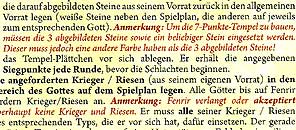 |
|
|
| x |
|
|
|
|
|
|
|
|
|
|
|
|
|
|
|
|
|
|
|
|
|
|
|
|
|
|
|
|
|
|
|
|
|
|
|
|
|
|
|
|
|
|
|
|
|
|
|
|
|
|
|
|
|
|
|
|
|
|
|
| It can’t be said often enough so here goes again: it would be nice if the smaller publisher not only took the trouble to involve respected playtesters in the game, but also submit the rules to - free lance - editors such as working for Hans im Glück, Pegasus Spiele or Kosmos, who have found a pleasant and intuitive way to introduce players into the game. Urgent advice: take the trouble, otherwise it takes - and so here again - points reduction in the review! |
|
|
| x |
|
|
|
|
|
|
|
|
|
|
|
|
|
|
|
|
|
|
|
|
|
|
|
|
|
|
|
|
|
|
|
|
|
|
|
|
|
|
|
|
|
|
|
|
|
|
|
|
|
|
|
|
|
|
|
|
|
|
|
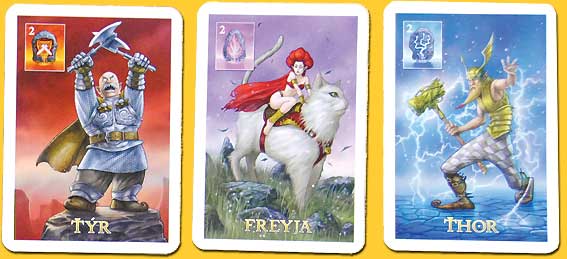 |
|
|
| x |
|
|
|
|
|
|
|
|
|
|
|
|
|
|
|
|
|
|
|
|
|
|
|
|
|
|
|
|
|
|
|
|
|
|
|
|
|
|
|
|
|
|
|
|
|
|
|
|
|
|
|
|
|
|
|
|
|
|
|
|
When everything finally falls into place, it is clear that players may take influence at the gods, hoping to have taken the right position as in a Last Gods Battle each god scores points.
Players simultaneously choose and alternately play god cards from a set that is identical for each player, and place an action disc at the chosen god. As many god cards can be played as a player has action discs, each player starts the game with three but he may acquire more by playing a god card and placing an action disc in the Asgard area where discs, warriors and giants can be bought.
|
|
|
| x |
|
|
|
|
|
|
|
|
|
|
|
|
|
|
|
|
|
|
|
|
|
|
|
|
|
|
|
|
|
|
|
|
|
|
|
|
|
|
|
|
|
|
|
|
|
|
|
|
|
|
|
|
|
|
|
|
|
|
|
|
Each god facilitates three action discs: two to acquire resources for building temples, and one to actually build a temple and subsequently take the influence at that god. The three spaces can be taken by different players, but never more than one per space.
|
|
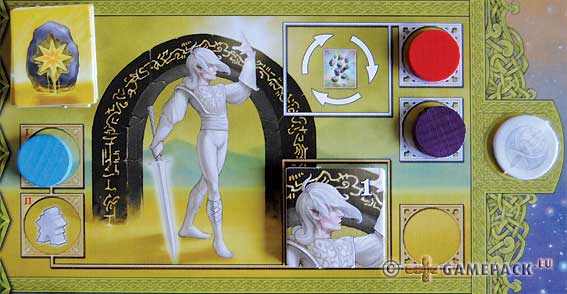 |
|
|
| x |
|
|
|
|
|
|
|
|
|
|
|
|
|
|
|
|
|
|
|
|
|
|
|
|
|
|
|
|
|
|
|
|
|
|
|
|
|
|
|
|
|
|
|
|
|
|
|
|
|
|
|
|
|
|
|
|
|
|
|
The first player at a building space to perform his action also takes the seal that goes with the god: a light one for a god of the light side, and a dark one for a god who sympathizes with the dark side. The seals are necessary when a player wants to buy new action discs, warriors or giants in Asgard; an alternative location for a played god card.
A player in the upper space of a god field takes the two resources that go with the god but also may perform a bonus action, varying from exchanging resources, taking warriors or giants, changing the player order, and so on. |
|
|
| x |
|
|
|
|
|
|
|
|
|
|
|
|
|
|
|
|
|
|
|
|
|
|
|
|
|
|
|
|
|
|
|
|
|
|
|
|
|
|
|
|
|
|
|
|
|
|
|
|
|
|
|
|
|
|
|
|
|
|
|
 |
|
The temples on the game board come in four varieties, ranging from requiring only two resources, to four different resources, always including one that comes with Odin. When a player has placed his action disc on the temple space, he may build a temple of his choice. The resources are turned in and the temple is placed in front of the player who at the end of each round is rewarded the points for it, from three to seven points. Before building the temple, the player must turn in warriors or giants of a specific colour; these will support the god at the end of the game in the Mother of All God Battles. As a last action when the temple has been built, the player takes the upper god chit from the stack in the god field and places it in one of the spaces in the Yggdrasil area.
|
|
|
| x |
|
|
|
|
|
|
|
|
|
|
|
|
|
|
|
|
|
|
|
|
|
|
|
|
|
|
|
|
|
|
|
|
|
|
|
|
|
|
|
|
|
|
|
|
|
|
|
|
|
|
|
|
|
|
|
|
|
|
|
|
Each god has a strength from one to four and this again is important at the final Battle of the Gods but also at interim battles taking place at the end of each round.
Initially Yggdrasil houses only mortals; when a temple has been built a player replaces one of these for the god chit he took. Each peoples chit has a one time bonus that can be taken right away or be saved for a later turn or round.
|
|
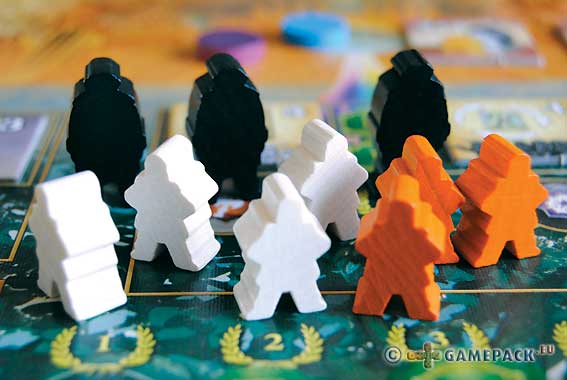 |
|
|
| x |
|
|
|
|
|
|
|
|
|
|
|
|
|
|
|
|
|
|
|
|
|
|
|
|
|
|
|
|
|
|
|
|
|
|
|
|
|
|
|
|
|
|
|
|
|
|
|
|
|
|
|
|
|
|
|
|
|
|
|
|
|
|
|
| x |
|
|
|
|
|
|
|
|
|
|
|
|
|
|
|
|
|
|
|
|
|
|
|
|
|
|
|
|
|
|
|
|
|
|
|
|
|
|
|
|
|
|
|
|
|
|
|
|
|
|
|
|
|
|
|
|
|
|
|
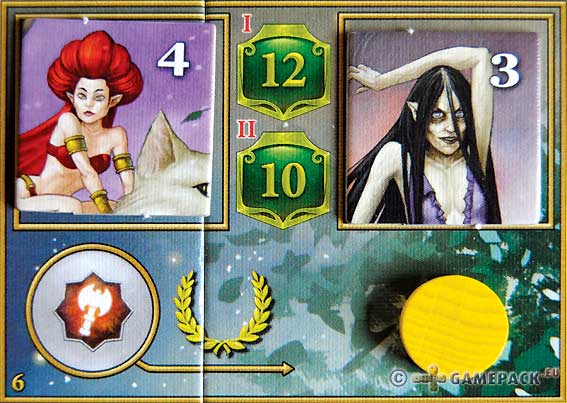 |
|
The interim battles in Yggdrasil at the end of a round are resolved by comparing the strength of a god with a peoples chit, added with the strength of weapons chits that are turned face up, one for the light side and one for the dark side. When this value is higher than an opposing god or people, players with an action disc may push their disc to the victory side; otherwise the disc is returned to the player. |
|
|
| x |
|
|
|
|
|
|
|
|
|
|
|
|
|
|
|
|
|
|
|
|
|
|
|
|
|
|
|
|
|
|
|
|
|
|
|
|
|
|
|
|
|
|
|
|
|
|
|
|
|
|
|
|
|
|
|
|
|
|
|
| These action discs stay in Yggrasil until near the end of the game, when the Grande Bataille des Dieux gets started; it no longer is available for actions but each disc here scores points each round: from a 3 point marker for a single disc to a 20 point marker for five discs, provided this marker still is available and not already taken by another player lower in player order. |
|
|
| x |
|
|
|
|
|
|
|
|
|
|
|
|
|
|
|
|
|
|
|
|
|
|
|
|
|
|
|
|
|
|
|
|
|
|
|
|
|
|
|
|
|
|
|
|
|
|
|
|
|
|
|
|
|
|
|
|
|
|
|
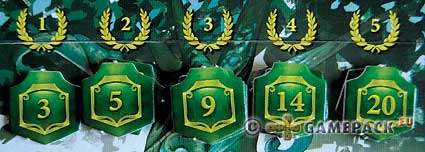 |
|
When all battles have been resolved, a round is over and a new one begins with simultaneously choosing and alternately playing god cards, as much as a player has action discs available. |
|
|
| x |
|
|
|
|
|
|
|
|
|
|
|
|
|
|
|
|
|
|
|
|
|
|
|
|
|
|
|
|
|
|
|
|
|
|
|
|
|
|
|
|
|
|
|
|
|
|
|
|
|
|
|
|
|
|
|
|
|
|
|
|
After the fifth round the long awaited and announced Final and Ultimate Gods Battle is conducted. First, all action discs in Yggdrasil are removed; for these points were scored already during the game. After this action discs from players that are placed at temple fields, as well as the warriors and giants there, are transferred to the corresponding field in Yggrasil; players may add warriors and giants from Asgard as well as weapon chits that were collected during the game, supporting or weakening gods. There are first and second places but when a player is the only one supporting a god he scores for both positions!
|
|
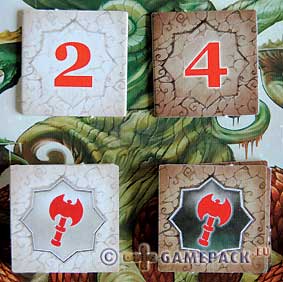 |
|
|
| x |
|
|
|
|
|
|
|
|
|
|
|
|
|
|
|
|
|
|
|
|
|
|
|
|
|
|
|
|
|
|
|
|
|
|
|
|
|
|
|
|
|
|
|
|
|
|
|
|
|
|
|
|
|
|
|
|
|
|
|
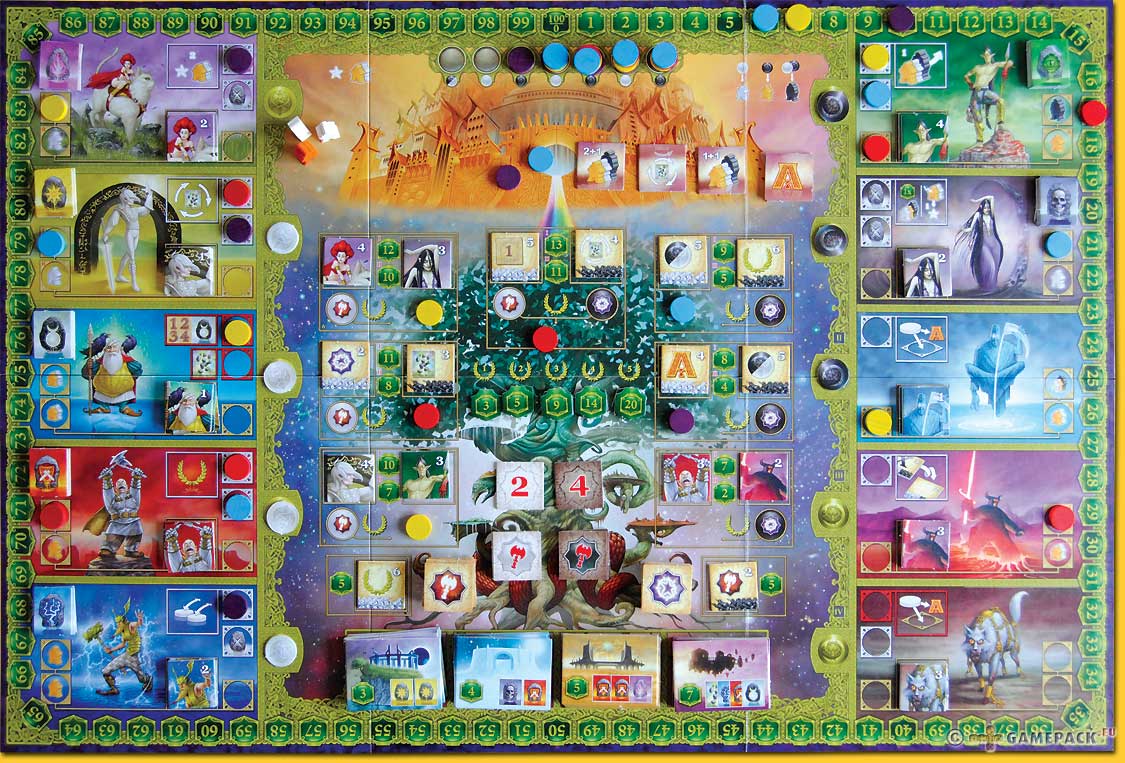 |
| x |
| x |
| x |
 |
|
|
|
|
|
|
|
|
|
|
|
|
|
|
|
|
|
|
|
|
|
|
|
|
|
|
|
|
|
|
|
|
|
|
|
|
|
|
|
|
|
|
|
|
|
|
|
|
|
|
| It must be clear to any in player order fourth player: he does not want to stay in this position! When players have chosen the same god, he is the one left out: both bonus action and seal is taken. A player who has his action disc in the upper space may alter the player order. But Odin is popular for yet another reason: a white resource can be taken here that is required to build the most rewarding temple, so the question remains if the fourth player can do the bonus action in the first round right away. |
|
|
| x |
|
|
|
|
|
|
|
|
|
|
|
|
|
|
|
|
|
|
|
|
|
|
|
|
|
|
|
|
|
|
|
|
|
|
|
|
|
|
|
|
|
|
|
|
|
|
|
|
|
|
|
|
|
|
|
|
|
|
|
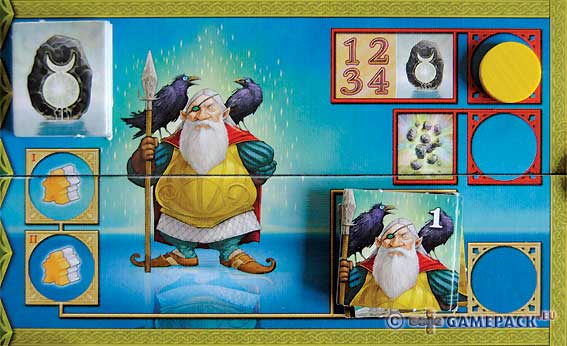 |
|
|
| x |
|
|
|
|
|
|
|
|
|
|
|
|
|
|
|
|
|
|
|
|
|
|
|
|
|
|
|
|
|
|
|
|
|
|
|
|
|
|
|
|
|
|
|
|
|
|
|
|
|
|
|
|
|
|
|
|
|
|
|
| The fourth player has a clear disadvantage, so much is clear. Initially seven gods can be chosen from, but the chances that in the first round for whatever reason players have chosen the same god are quite high. It has occurred that the fourth player had to place two of his three action discs in Asgard, as the god he had chosen was already taken by two other players. This gives this player a substantial backlog; besides that a player can’t do much in Asgard without any seals. |
|
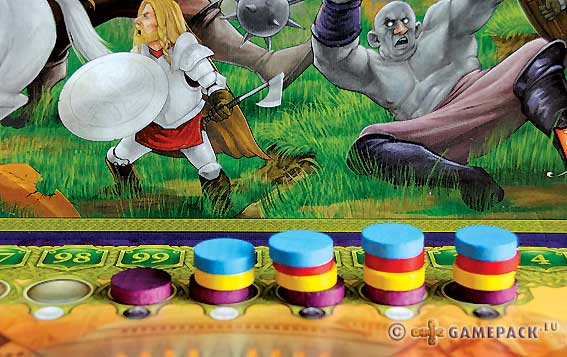 |
| x |
|
|
|
|
|
|
|
|
|
|
|
|
|
|
|
|
|
|
|
|
|
|
|
|
|
|
|
|
|
|
|
|
|
|
|
|
|
|
|
|
|
|
|
|
|
|
|
|
|
|
|
|
|
|
|
|
|
|
|
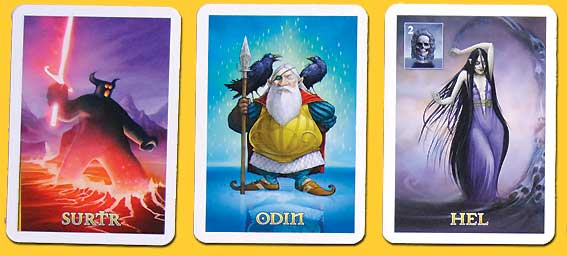 |
While other players have already been able to buy a fourth action disc, and have scored for this disc in Yggdrasil, the fourth player enters the second round with anew his initial three discs, again with the aim of getting rid of the fourth position; but with this enforced action his arrears even is further increased. |
|
|
|
A nice element is that players first choose and play their god cards, and then, again in player order, actions are performed. When overseeing all positions this can offer different priorities and therefore changes in the settlement of his actions.
The game can be played from two to four players, but despite the disadvantage for the fourth player, the game is less playable with two and three players; with these player amounts there is simply too much space on the board.
|
|
|
| x |
|
|
|
|
|
|
|
|
|
|
|
|
|
|
|
|
|
|
|
|
|
|
|
|
|
|
|
|
|
|
|
|
|
|
|
|
|
|
|
|
|
|
|
|
|
|
|
|
|
|
|
|
|
|
|
|
|
|
|
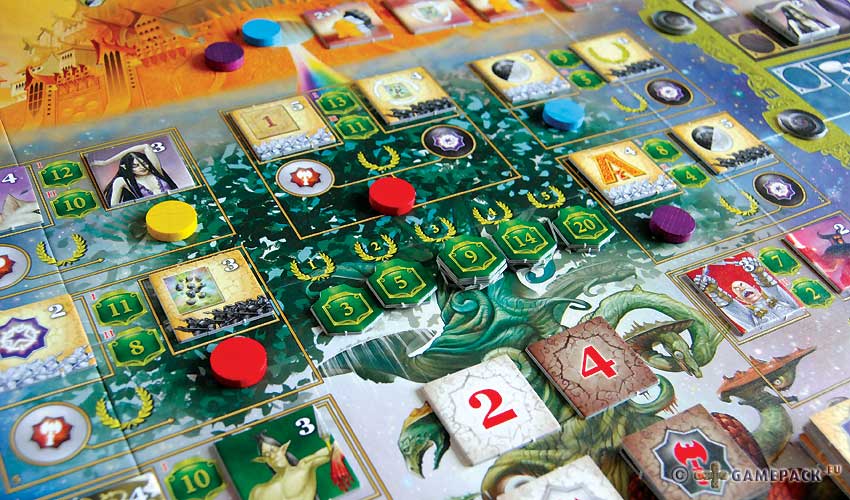 |
| x |
|
|
|
|
|
|
|
|
|
|
|
|
|
|
|
|
|
|
|
|
|
|
|
|
|
|
|
|
|
|
|
|
|
|
|
|
|
|
|
|
|
|
|
|
|
|
|
|
|
|
|
|
|
|
|
|
|
|
|
|
Much attention has been paid to give the game board atmosphere - the illustration style should appeal to you however - but as a consequence there is no overview, and unnecessary space is accorded that could be used otherwise, to place game components on the board for example, instead of next to it. This all seems nit-picking, but these are all things that contribute or haggle at the playing feel and a smooth game. Why, for example, are the spaces in Yggdrasil rather confusing numbered from bottom right to top right and from bottom left to upper left? Again, a proper editor is sorely missed.
|
|
|
| x |
|
|
|
|
|
|
|
|
|
|
|
|
|
|
|
|
|
|
|
|
|
|
|
|
|
|
|
|
|
|
|
|
|
|
|
|
|
|
|
|
|
|
|
|
|
|
|
|
|
|
|
|
|
|
|
|
|
|
|
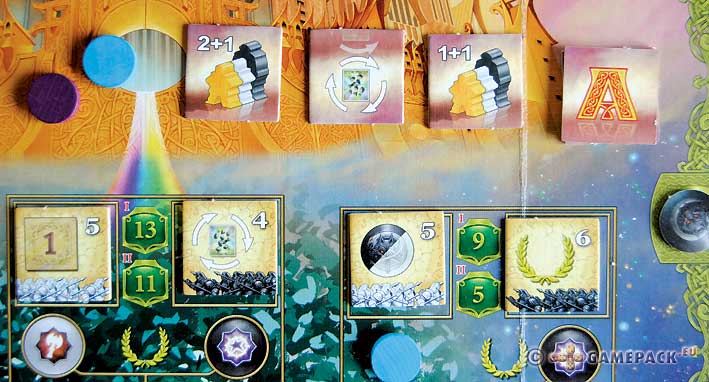 |
|
|
| x |
|
|
|
|
|
|
|
|
|
|
|
|
|
|
|
|
|
|
|
|
|
|
|
|
|
|
|
|
|
|
|
|
|
|
|
|
|
|
|
|
|
|
|
|
|
|
|
|
|
|
|
|
|
|
|
|
|
|
|
| But it is all too much, too much stuff, too many rules, too many components; a typical feature of the smaller publishers who perhaps benevolently go with the wishes and ideas of the author instead of giving advice to cut into the concept and thus make the game slimmer and more attractive. The pitfall where a novice author must be protected from is that he immediately wants to create his Magnus Opum, risking creating a non viable monster that will not come to life at all. It is no coincidence that the larger games, both in complexity, rules and components, are published either in-house or at smaller, less critical or less professional smaller publishers. |
|
|
| x |
|
|
|
|
|
|
|
|
|
|
|
|
|
|
|
|
|
|
|
|
|
|
|
|
|
|
|
|
|
|
|
|
|
|
|
|
|
|
|
|
|
|
|
|
|
|
|
|
|
|
|
|
|
|
|
|
|
|
|
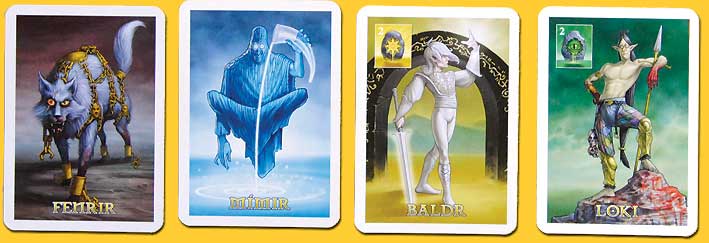 |
|
|
| x |
|
|
|
|
|
|
|
|
|
|
|
|
|
|
|
|
|
|
|
|
|
|
|
|
|
|
|
|
|
|
|
|
|
|
|
|
|
|
|
|
|
|
|
|
|
|
|
|
|
|
|
|
|
|
|
|
|
|
|
|
Asgard’s first impression is that of a strategic game, but this is off set by the accidental deployment of the god cards, whereby players unexpectedly are faced with competition that thwarts their plan. The question arises whether this is an attractive option; at least it affects the further tactical intent of the game.
After the peak ‘Vasco da Gama’ and the overly complex ‘Vinhos’, the somewhat simpler ‘Asgard’ is a downright disappointment.
© 2013 Richard van Vugt
Asgard, Pierluca Zizzi, What’s Your Game? / Hutter Trade, 2012 - 2 to 4 players, 12 years and up, 90 minutes
|
|
|
  |
|
|
|
|
|
|
|
|
|
|
|
|
|
|
|
|
|
|
|
|
|
|
|
|
|
|
|
|
|
|
|
|
|
|
|
|
|
|
|
|
|
|
|
|
|
|
|
|
|
|
  |
|
|
|
|
|
|
|
|
|
|
|
|
|
|
|
|
|
|
|
|
|
|
|
|
|
|
|
|
|
|
|
|
|
|
|
|
|
|
|
|
|
|
|
|
|
|
|
|
|
|
  |
|
|
|
|
|
|
|
|
|
|
|
|
|
|
|
|
|
|
|
|
|
|
|
|
|
|
|
|
|
|
|
|
|
|
|
|
|
|
|
|
|
|
|
|
|
|
|
|
|
|
|
|
|
|
|
|
|
|
|
|
|
|
|
|
|
|
|
|
|
|
|
|
|
|
|
|
|
|
|
|
|
|
|
|
|
|
|
|
|
|
|
|
|
|
|
|
|
|
|
|
|
| x |
|
|
|
|
|
|
|
|
|
|
|
|
|
|
|
|
|
|
|
|
|
|
|
|
|
|
|
|
|
|
|
|
|
|
|
|
|
|
|
|
|
|
|
|
|
|
|
|
|
|
|
|
|
|
|
|
|
|
|
| x |
|
|
|
|
|
|
|
|
|
|
|
|
|
|
|
|
|
|
|
|
|
|
|
|
|
|
|
|
|
|
|
|
|
|
|
|
|
|
|
|
|
|
|
|
|
|
|
|
|
|
|
|
|
|
|
|
|
|
|
 |
|
|
|
|
|
|
|
|
|
|
|
|
|
|
|
|
|
|
|
|
|
|
|
|
|
|
|
|
|
|
|
|
|
|
|
|
|
|
|
|
|
|
|
|
|
|
|
|
|
|
 |
|
|
|
|
|
|
|
|
|
|
|
|
|
|
|
|
|
|
|
|
|
|
|
|
|
|
|
|
|
|
|
|
|
|
|
|
|
|
|
|
|
|
|
|
|
|
|
|
|
|
| x |
|
|
|
|
|
|
|
|
|
|
|
|
|
|
|
|
|
|
|
|
|
|
|
|
|
|
|
|
|
|
|
|
|
|
|
|
|
|
|
|
|
|
|
|
|
|
|
|
|
|
|
|
|
|
|
|
|
|
|
 |
|
|
|
|
|
|
|
|
|
|
|
|
|
|
|
|
|
|
|
|
|
|
|
|
|
|
|
|
|
|
|
|
|
|
|
|
|
|
|
|
 |
|
|
|
|
|
|
|
|
|
|
|
|
|
|
|
|
|
|
|
|
|
|
|
|
|
|
|
|
|
|
|
|
|
|
|
|
|
|
|
|
|
|